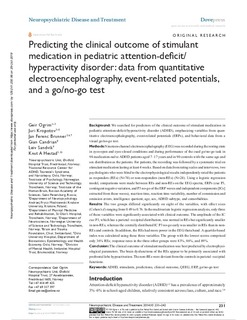| dc.contributor.author | Øgrim, Kjell Geir | |
| dc.contributor.author | Kropotov, Yury | |
| dc.contributor.author | Brunner, Jan | |
| dc.contributor.author | Candrian, Gian | |
| dc.contributor.author | Sandvik, Leiv | |
| dc.contributor.author | Hestad, Knut | |
| dc.date.accessioned | 2019-11-04T13:33:08Z | |
| dc.date.available | 2019-11-04T13:33:08Z | |
| dc.date.created | 2014-02-19T15:48:20Z | |
| dc.date.issued | 2014 | |
| dc.identifier.citation | Neuropsychiatric Disease and Treatment. 2014, 10 231-242. | nb_NO |
| dc.identifier.issn | 1176-6328 | |
| dc.identifier.uri | http://hdl.handle.net/11250/2626419 | |
| dc.description.abstract | Background: We searched for predictors of the clinical outcome of stimulant medication in pediatric attention-deficit/hyperactivity disorder (ADHD), emphasizing variables from quantitative electroencephalography, event-related potentials (ERPs), and behavioral data from a visual go/no-go test.
Methods: Nineteen-channel electroencephalography (EEG) was recorded during the resting state in eyes-open and eyes-closed conditions and during performance of the cued go/no-go task in 98 medication-naïve ADHD patients aged 7–17 years and in 90 controls with the same age and sex distribution as the patients. For patients, the recording was followed by a systematic trial on stimulant medication lasting at least 4 weeks. Based on data from rating scales and interviews, two psychologists who were blind to the electrophysiological results independently rated the patients as responders (REs) (N=74) or non-responders (non-REs) (N=24). Using a logistic regression model, comparisons were made between REs and non-REs on the EEG spectra, ERPs (cue P3, contingent negative variation, and P3 no-go of the ERP waves and independent components [ICs] extracted from these waves), reaction time, reaction time variability, number of commission and omission errors, intelligence quotient, age, sex, ADHD subtype, and comorbidities.
Results: The two groups differed significantly on eight of the variables, with effect sizes (Cohen's d) ranging from 0.49 to 0.76. In the multivariate logistic regression analysis, only three of these variables were significantly associated with clinical outcome. The amplitude of the IC cue P3, which has a parietal–occipital distribution, was normal in REs but significantly smaller in non-REs, whereas the centrally distributed IC P3 no-go early was smaller in REs than in non-REs and controls. In addition, the REs had more power in the EEG theta band. A quartile-based index was calculated using these three variables. The group with the lowest scores comprised only 36% REs; response rates in the three other groups were 83%, 86%, and 89%.
Conclusion: The clinical outcome of stimulant medication was best predicted by electrophysiological parameters. The brain dysfunctions of the REs appear to be primarily associated with prefrontal lobe hypoactivation. The non-REs were deviant from the controls in parietal–occipital functions. | nb_NO |
| dc.language.iso | eng | nb_NO |
| dc.publisher | Dove Medical Press | nb_NO |
| dc.rights | Navngivelse-Ikkekommersiell 4.0 Internasjonal | * |
| dc.rights.uri | http://creativecommons.org/licenses/by-nc/4.0/deed.no | * |
| dc.title | Predicting the clinical outcome of stimulant medication in pediatric attention-deficit/hyperactivity disorder: data from quantitative electroencephalography, event-related potentials, and a go/no-go test | nb_NO |
| dc.type | Journal article | nb_NO |
| dc.type | Peer reviewed | nb_NO |
| dc.description.version | publishedVersion | nb_NO |
| dc.source.pagenumber | 231-242 | nb_NO |
| dc.source.volume | 10 | nb_NO |
| dc.source.journal | Neuropsychiatric Disease and Treatment | nb_NO |
| dc.identifier.doi | 10.2147/NDT.S56600 | |
| dc.identifier.cristin | 1116812 | |
| dc.description.localcode | © 2014 Ogrim et al. This work is published by Dove Medical Press Limited, and licensed under Creative Commons Attribution – Non Commercial (unported, v3.0) License. The full terms of the License are available at http://creativecommons.org/licenses/by-nc/3.0/. Non-commercial uses of the work are permitted without any further permission from Dove Medical Press Limited, provided the work is properly attributed. Permissions beyond the scope of the License are administered by Dove Medical Press Limited. Information on how to request permission may be found at: http://www.dovepress.com/permissions.php | nb_NO |
| cristin.unitcode | 194,67,40,0 | |
| cristin.unitcode | 194,65,30,0 | |
| cristin.unitcode | 1920,5,0,0 | |
| cristin.unitname | Institutt for psykologi | |
| cristin.unitname | Institutt for nevromedisin og bevegelsesvitenskap | |
| cristin.unitname | Klinikk for fysikalsk medisin og rehabilitering | |
| cristin.ispublished | true | |
| cristin.fulltext | original | |
| cristin.qualitycode | 1 | |

